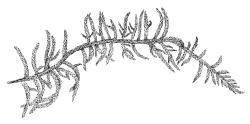Description as per Hylocomium splendens:
Plants medium-sized, yellow- to olive-green, mostly dull or faintly lustrous, forming loose wefts. Stems prostrate or ascendant and self-supporting, wiry, red-brown, densely beset with filamentous paraphyllia, commonly 60–120 mm long in N.Z. material, irregularly subpinnate (in N.Z. material), often with scarcely-branched horizontal stolons, in cross-section with several layers of thick-walled cortical cells surrounding a medulla of prosenchymatous cells, lacking a central strand; rhizoids lacking (or infrequent fide Rohrer); branches densely spaced on stems, short, c. 10 mm, simple or branched, distinctly curved (especially near tips), tapered apically and when dry sometimes appearing weakly cuspidate. Stem and branch leaves differentiated. Stem leaves erect and overlapping, oblong-ovate, abruptly narrowed to a short and ± channelled acumen (in N.Z. material), concave, smooth when moist, ± striolate when dry, slightly narrowed and not clasping at base, c. 1.5–1.8 × 0.8–1.1 mm, c. 2:1; margins narrowly reflexed near base, plane above, often pinched at the base of the acumen, distantly serrulate or crenulate below, distinctly serrulate at acumen; mid laminal cells vermicular, strongly prorate, variably porose, 30–45(–54) × c. 5 µm and 10–13:1, becoming longer and more distinctly porose towards leaf base; cells at insertion orange-brown, incrassate, strongly porose, forming a pigmented band across the leaf base; alar cells not differentiated or slightly wider than adjacent basal cells. Costae double, often ± pigmented, extending ¼–½ the leaf length. Branch leaves much smaller, ± elliptic, distinctly narrowed to base, abruptly narrowed to a broad and obtuse apex, c. 0.8–1.0 mm on well-developed primary branches (smaller near branch tips or on secondary branches). Costae shorter and sometimes ± absent. Paraphyllia abundant on stems and branches, much-branched and filamentous. Pseudoparaphyllia not seen.
Dioicous. Perichaetia scattered on stems, the leaves ovate-lanceolate, spreading at tips, ecostate, c. 1.5 mm. Perigonia and sporophytes unknown in N.Z.
Hylocomium was treated as a monotypic genus by Rohrer (1985). Some 20th century Floras (e.g., Crum & Anderson 1981) treated more species, but these were placed in either Hylocomiastrum or Loeskeobryum Rohrer (1985), whose treatment has been followed in more recent floristic treatments (e.g., Smith 2004).
| Category | Number |
|---|---|
| Indigenous (Non-endemic) | 1 |
| Total | 1 |




